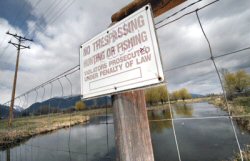Muddy Waters is an excellent article about Mitchell Slough in this weeks Missoula Independent. The article covers much of the long and convoluted history of the private/public controversy over the waters of Mitchell Slough. Bugle readers will remember our coverage of SB314 back in February. The bill, from early in the legislative session, was presented by Senator Rick Laible of Darby at the behest of some wealthy landowners as an end-run around the Montana Supreme Court ruling that the slough was open to public access. Rightly so, Senator Laible pulled the bill after putting up with as much outrage from local constituents as he could stand.
The Independent article leans heavily on the role of the various public entities who oversee Montana water laws. It has good coverage of the controversy surrounding the

Photo From The Missoula Independent
Bitterroot Conservation District and it’s regulation of 310 permits for the slough. 310 permits have been required by Montana law since 1975 with the passage of the Natural Streambed and Land Preservation Act, known as the 310 Law. The intent of the 310 law was that “natural rivers and streams and the lands and property immediately adjacent to them within the state are to be protected and preserved to be available in their natural or existing state…” Issuing permits to work in, or adjacent to, natural streams falls under the jurisdiction of the board of supervisors of the local conservation districts. The Bitterroot Conservation District had issued 310 permits for Mitchell Slough since the inception of the law, in essence recognizing the slough as a natural waterway. In 1999, the BCD decided, with no public or state input, to no longer issue 310 permits for Mitchell Slough. It was probably only coincidence that at the time, they had under consideration a controversial request for a 310 permit from a wealthy landowner to divert water from the slough to create private fish and waterfowl ponds for the use of himself and his friends. Not long afterward, the BCD declared that Mitchell Slough was “not a natural perennial flowing stream”. This unilateral declaration, in part, set off the firestorm that eventually led to the Supreme Court ruling.
The article somewhat rakes the BCD over the coals for decisions made in the case of Mitchell Slough. Conservation districts are a vital part of the protection of streams and rivers across the state of Montana. They have done a heck of a lot of good work for Montana sportsmen, ranchers and farmers for many years. The boards of the conservation districts tend to be made up of long-time farmers and ranchers, because they are the ones who most often deal with irrigation issues. In the case of Mitchell Slough as in other cases that seem to crop up more often in recent years, it has become clear that sometimes the boards are not equipped to deal with current legal issues of unfettered development and conflicts between sportsmen and landowners. This is in no way a criticism of the boards or the process, it is merely a fact of life that water issues in Montana continue to become more and more complicated. Montanans owe a large debt of gratitude to our conservation districts. These are volunteers, elected by local folks. They deserve our help and our support. They are our first line of defense in maintaining the health of Montana streams and rivers. As retired Ravalli County Justice of the Peace stated “The privatization of a river or stream is a mistake, no man should own a stream, Mitchell Slough is a stream and it is not for sale.”
Filed under: Button Valley News, Montana News, Wildlife and Environment |






[…] This is the link to Lucky’s post on 310 permits, the Bitteroot Conservation District and Mitchell slough. Be sure to read the excellent Missoulian article he mentions. It pretty much covers the history and workings of the Bitteroot Conservation District, the 310 permit and an example of how they have played out in Mitchell slough. The article title is o’ so appropriate! […]